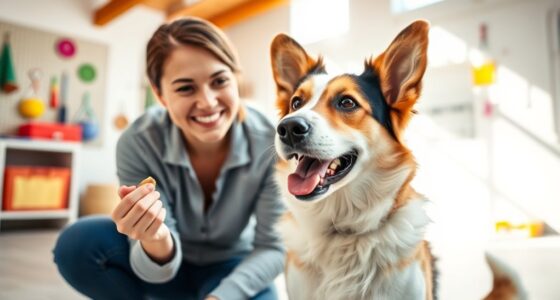When introducing your adult dog to new dogs or environments, patience and consistency are key. Gradually expose your dog to new sights, sounds, and smells while rewarding calm behavior. Use positive reinforcement and start with short sessions, slowly increasing exposure. Tailor your approach based on your dog’s breed and personality, and always watch for signs of stress. With time and gentle guidance, your dog will grow confident—continue exploring ways to make socialization smoother.
Key Takeaways
- Introduce new dogs gradually in controlled settings, rewarding calm behavior to build positive associations.
- Use short, positive exposure sessions to familiarize adult dogs with new environments and stimuli.
- Be patient and consistent, adjusting approaches based on the dog’s breed traits and comfort level.
- Observe signals of stress or discomfort, retreat if necessary, and reinforce calm, confident responses.
- Tailor socialization techniques to individual dogs, ensuring slow progress to prevent overwhelm and promote confidence.

Socializing an adult dog can seem challenging, but with patience and consistency, it’s entirely achievable. When introducing your dog to new environments or other animals, understanding breed-specific traits is essential. Some breeds are naturally more social and eager to meet new people, while others may be more reserved or territorial. Recognizing these tendencies helps you tailor your approach, ensuring your dog feels safe and confident during new experiences. For instance, a herding breed might thrive on activity and social interaction, whereas a more independent breed may need gentle encouragement and patience. Knowing these traits allows you to set realistic expectations and avoid overwhelming your dog.
Using effective training techniques plays a critical role in successful socialization. Start with short, positive sessions and gradually increase exposure to different stimuli. Reward-based training works best here—praise, treats, or toys—reinforce your dog’s good behavior and help build trust. Keep in mind that adult dogs may have past experiences that influence their reactions, so patience is key. If your dog shows signs of anxiety or fear, slow down and give them time to process the situation. Consistency in your training techniques is essential; routine helps your dog understand what to expect and reduces stress. When introducing your dog to new environments, go at a pace that suits their comfort level, and always be ready to retreat or modify the approach if needed.
Socialization isn’t just about meeting other dogs or people; it’s also about acclimating your dog to different sights, sounds, and smells. Use positive reinforcement to guide your dog through these new experiences. For example, if your dog is uncomfortable around loud noises, start with gentle exposure in a controlled setting, rewarding calm behavior. Over time, their confidence will grow, and they’ll learn that these new stimuli aren’t threatening. Remember, every dog is unique, so what works for one may not work for another. Adjust your training techniques accordingly, and don’t rush the process. Patience and persistence are your best tools for helping your adult dog become more comfortable and well-adjusted in various settings.
Frequently Asked Questions
How Long Does Socialization Take for an Adult Dog?
Socialization for an adult dog can take several weeks to months, depending on the dog’s history and temperament. You should focus on timing considerations, gradually introducing new experiences without overwhelming your dog. Use positive training techniques to reinforce calm behavior and confidence. Consistency is key; regular, gentle exposure helps your dog become comfortable with new dogs and environments over time. Patience and persistence will guarantee successful socialization.
Can Aggressive Adult Dogs Be Socialized Successfully?
You can turn the tide with aggressive adult dogs, but it’s a tall order. Success depends on understanding dog behavior and applying effective training techniques. Consistent, positive reinforcement helps build trust, while patience is key—sometimes you have to bend over backwards. With the right approach and dedication, even aggressive dogs can become more social. Remember, every dog is different, so tailor your training to fit their unique needs.
What Are Signs of Stress During Socialization?
You might notice signs of stress during socialization, like tense body language cues—stiff posture, pinned ears, or a tucked tail. Vocalizations such as growling, barking, or whining also indicate discomfort. Watch for rapid breathing or excessive panting, which can signal anxiety. If your dog shows these signs, give them space, use calming techniques, and avoid pushing too hard, ensuring they feel safe and secure during the process.
How to Socialize a Shy or Fearful Adult Dog?
Think of handling fear like gently guiding a fragile flower in bloom. To socialize your shy adult dog, start slow with controlled, positive experiences. Use positive reinforcement to reward calm behavior and build their confidence. Introduce new dogs and environments gradually, avoiding overwhelming them. Patience is key; over time, your dog will learn to trust and enjoy social interactions, transforming fear into curiosity and companionship.
Are There Specific Breeds That Adapt Better to Socialization?
Some breeds tend to adapt better to socialization, making your efforts more successful. Breeds like Labrador Retrievers, Golden Retrievers, and Beagles generally have high breed adaptability and are often more open to new experiences. These breeds usually respond well to socialization efforts, increasing the chances of socialization success. However, individual temperament matters, so patience and consistent positive reinforcement are key regardless of breed.
Conclusion
Now that you understand the importance of socialization for your adult dog, the real challenge begins. Every new environment and encounter holds the potential to transform your dog’s confidence—and yours. Will you take the steps needed to introduce them to new experiences, or let fear hold you back? The choice is yours, but one thing’s certain: with patience and consistency, you’re on the verge of unblocking a more confident, happy companion. Are you ready to start?









